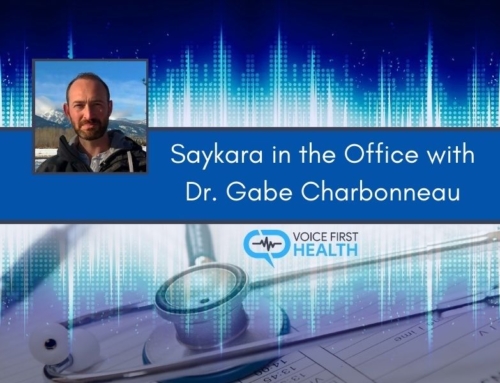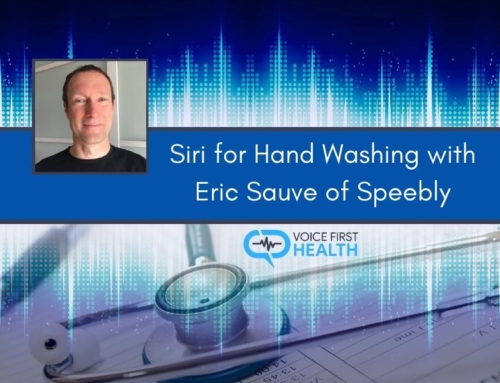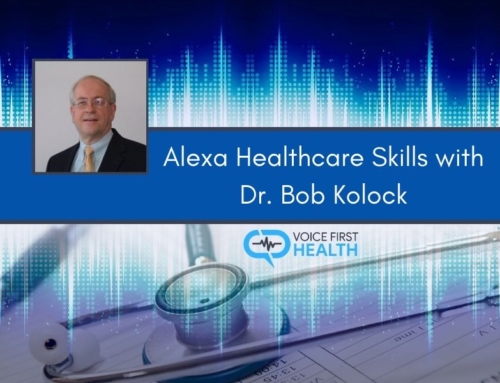VFH Episode 59
In this episode, Teri will give us a preview of the Voice Technology in Healthcare book that he co-wrote with David Metcalf (PhD), Sandhya Pruthi (MD), and Harry Pappas.
Teri has made a compilation of a number of different people who contributed to the book which will be officially launched at HIMSS (Healthcare Information and Management Systems Society), a major medical information conference which will take place in Orlando, Florida on March 10th 2020. The book brings together the expertise of 32 thought leaders in different areas at the intersection of voice technology and healthcare.
Key Points!
- The Voice Technology in Healthcare book and how it can be useful to all of us.
- How the book covers a cross section of the voice technology industry; where the industry is at today, a history of it, what is available right now, and its future.
The Voice Technology in Healthcare book
- It’s divided into four main sections. Section one is made up of four different chapters and they serve as an introduction to voice technology. They cover some of the key concepts of voice technology in healthcare. The chapters include:
Chapter 1
- This was written by Teri and includes an overview of why voice is such an important concept when it comes to healthcare and technology. Teri shares why he feels voice will transform healthcare and become the next operating system (Voice Operating System).
Chapter 2
- It was written by Ilana Meir who has spoken at different voice events. She is the world’s most foremost expert on Voice User Interface design (VUI), and how it applies to healthcare. This will help in the design of voice applications because VUI is critical.
Chapter 3
- It was written by Audrey Arbeeny, the founder and CEO of Audiobrain. The chapter is titled, “The Science Behind Sonic Branding: How Audio Can Create Better Patient, Caregiver, and Healthcare Provider Outcomes.” She discussed her 25 years’ experience working in healthcare, how the brain processes music and sound, and why sound is the perfect tool for communicating, helping to heal, and promoting wellness. She discusses some of the projects her company has worked on, the history of the voice industry, and where it’s headed in the future.
Chapter 4
- It was written by Nathan Treloar from Orbita and it’s titled, “Secure Voice”.
Section 2
- This one has seven chapters which look at voice technology and the patient experience. The authors of these chapters are mostly people who have had experience with creating voice applications and how they impact patients. The chapters include:
Chapter 5
- It’s titled, “Automated Virtual Caregiving Using Voice First Services: Proactive, Personalized, Holistic, 24/7, and Affordable” It was written by Stuart Patterson from Lifepod.
Chapter 6
- This is about voice and wearables and was written by Dave Kemp.
Chapter 7
- This was written by Rupal Patel and it’s about synthetic voices for healthcare applications. Rupal has been doing some amazing work looking at how people can create voices for brands, but also for the medical field where a voice can be created for someone who is losing their voice.
Chapter 8 & 9
- These include edited versions of podcast interviews that took place in Voice First Health Podcast. Teri wanted to incorporate the interviews in the book to bring a real personal aspect to the narratives that readers will be reading in the book.
- Chapter 8 is titled, “Voice First Health Interview: An Diabetes Care Plan” This was with Anne Weiler who actually won an award for her diabetes Alexa skill.
- Chapter 9 is titled, “Voice First Health Interview: Alexa Skills for Pediatrics” This interview was with Devin Nadar speaking about some of her experiences with creating skills specifically for kids.
Chapter 10
- This one was written by Robin Christopherson, and it’s called “The Rapid Rise of Voice Technology and its Awesome Power to Empower” It’s all about accessibility and he wrote about how the Echo and voice first technology more broadly represents a fantastic opportunity for people with people with disabilities.
Chapter 11
- It’s titled, “An Overview of Voice Technology and Healthcare” and it’s by a team of authors from Macadamian Technologies.

Section 3
- It’s titled, “Voice Technology and the Provider Experience” and it’s all about what the healthcare provider is experiencing with voice technology.
Chapter 12
- It’s titled, “Mayo Clinic: Patient Centered, Innovation Driven” and it’s written by a team at the Mayo Clinic, including Dr. Sandhya Pruthi who is one of the cover authors of the book.
Chapter 13
- This is another Voice First Health interview titled, “Voice Technology for Behavioral Changes” where Teri talked to Dr. Matthew Cybulsky about how we can use voice technology to really influence positive behavioral changes with the hope of positive health outcomes.
Chapter 14
- It’s called “The Laws of Voice” and is written by two lawyers, Heather Deixler and Bianca Phillips.
Chapter 15
- This one is based on a Voice First Health Podcast interview, and is called “Medical Documentation in the Voice First Era” It features Dr. Harjinder Sandhu from Saykara and he talks about medical documentation through voice.
Chapter 16
- It’s written by Yaa Kumah-Crystal and Dan Albert from Vanderbilt University and they are looking at creating a voice enabled EMR (V-EVA). They discuss the considerations for designing a voice user interface like Siri or Alexa, to help doctors ask for information from the electronic health record, and have it summarized back by the computer in words.
Chapter 17
- It’s titled, “The Power of Voice in Western Medical Education” and it was written by Dr. Neel Desai and Dr. Taylor Brana. They are leaders when it comes to using voice to educate the next generation of medical students. They have an Alexa skill, MedFlashGo, that is doing just that.
Chapter 18
- This was written by Michelle Wan and is titled, “Voice First Health Interview: Voice Technology for Educational Simulations”
Chapter 19
- It was written by Ed Chung and is called, “Voice Control of Medical Hardware”. Ed talks about how voice is such a wonderful way to control medical hardware in a number of settings.
Section 4
- Its titled, “Voice Technology and the Future of Healthcare” and has four chapters, namely:
Chapter 20
- It’s titled, “Voice First Health Interview: Voice Applications with Dr. David Metcalf” and is about the fascinating things Dr. Metcalf and his team are doing that incorporate voice technology and healthcare.
Chapter 21
- This is titled, “Voice First Health Interview: Vocal Biomarkers and the Voice Genome Project with Jim Schwoebel” and Jim talks about some fascinating areas of vocal biomarkers and being able to diagnose diseases by listening to someone’s voice.
Chapter 22
- It was written by Suraj Kapa and is called, “Artificial Intelligence and Voice Analysis: Potential for Disease Identification and Monitoring” Suraj talks about how we can use voice to analyze different types of diseases and monitor diseases as well.
Chapter 23
- This is a roundtable discussion amongst Dr. David Metcalf, Dr. Sandhya Pruthi, and Teri. They talk about some of the themes, trends, and aha moments that they noticed in putting the book together.








